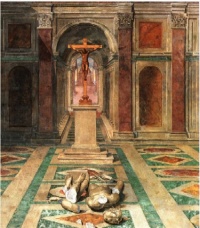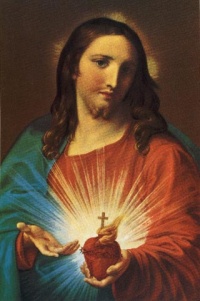Bible
From The Art and Popular Culture Encyclopedia
| Revision as of 18:52, 18 March 2014 Jahsonic (Talk | contribs) ← Previous diff |
Revision as of 18:54, 18 March 2014 Jahsonic (Talk | contribs) Next diff → |
||
| Line 1: | Line 1: | ||
| - | [[Image:Adam and Eve, temptation and banishment (Sistine Chapel ceiling by Michelangelo).jpg|thumb|200px|''[[Adam and Eve on the Sistine Chapel ceiling]]'' ([[1500s]]) of the [[Sistine Chapel ceiling ]] by [[Michelangelo]]. It is a [[panel]] from [[Adam and Eve on the Sistine Chapel ceiling|Adam and Eve cycle]]]] | + | [[Image:Sacred Heart by Pompeo Batoni.jpg|thumb|right|200px|''[[Il Sacro Cuore]]'', [[Church of the Gesù]], [[Rome]] by [[Pompeo Batoni]]]] |
| + | [[Image:Tommaso.Laureti.Triumph.of.Christianity.jpg|left|thumb|200px|This page '''{{PAGENAME}}''' is part of the [[Christianity]] series.<br><Small>Illustration: ''[[Triumph of Christianity]]'' (detail) by [[Tommaso Laureti]] (1530-1602.)</small>]] | ||
| + | [[Image:Hands of God and Adam.jpg|thumb|200px|''[[Hands of God and Adam]]'' ([[1500s]]) is a detail of the [[Sistine Chapel ceiling ]] by [[Michelangelo]]. It is a detail from [[Adam and Eve on the Sistine Chapel ceiling|Adam and Eve cycle]]]] | ||
| + | [[Image:Veronica's Veil (Francisco de Zurbarán, Bilbao).jpg|thumb|right|200px|''[[Veil of Veronica]]'' by [[Francisco de Zurbarán]], [[Bilbao Fine Arts Museum]], see [[Veronica's Veil (Francisco de Zurbarán) |...]]]] | ||
| + | [[Image:Index Librorum Prohibitorum.jpg|thumb|200px|right|The ''[[Index Librorum Prohibitorum]]'' ("[[banned books|List of Prohibited Books]]") is a list of publications which the [[Catholic|Catholic Church]] [[censorship|censored]] for being a [[danger]] to itself and the faith of its members. The various [[edition]]s also contain the rules of the [[Church]] relating to the reading, selling and censorship of books. The aim of the list was to prevent the reading of [[morality|immoral]] books or works containing [[theology|theological]] errors and to prevent the [[corruption]] of the faithful.]] | ||
| + | [[Image:Gheerhaets Allegory iconoclasm.jpg|200px|thumb|This page ''{{PAGENAME}}'' is a part of the [[protestantism]] series. | ||
| + | <br> | ||
| + | <small>Illustration: ''[[The image breakers]]'', c.[[1566]] –[[1568]] by [[Marcus Gheeraerts the Elder]]</small>]] | ||
| {{Template}} | {{Template}} | ||
Revision as of 18:54, 18 March 2014

Illustration: Triumph of Christianity (detail) by Tommaso Laureti (1530-1602.)


Illustration: The image breakers, c.1566 –1568 by Marcus Gheeraerts the Elder
|
Related e |
|
Featured: |
The word Bible refers to the canonical collections of sacred writings or books of Judaism and Christianity. The bible was the first mass produced book.
Contents |
Etymology
From Latin biblia, a collection of books (since there are many books in the Bible), eventually from the ancient Phoenician city of Byblos which exported this writing material.
Biblical criticism
Biblical criticism refers to the investigation of the Bible as a text, and addresses questions such as authorship, dates of composition, and authorial intention. It is not the same as criticism of the Bible, which is an assertion against the Bible being a source of information or ethical guidance, or observations that the Bible may have translation errors.
Higher criticism
In the 17th century Thomas Hobbes collected the current evidence to conclude outright that Moses could not have written the bulk of the Torah. Shortly afterwards the philosopher Baruch Spinoza published a unified critical analysis, arguing that the problematic passages were not isolated cases that could be explained away one by one, but pervasive throughout the five books, concluding that it was "clearer than the sun at noon that the Pentateuch was not written by Moses . . ." Despite determined opposition from Christians, both Catholic and Protestant, the views of Hobbes and Spinoza gained increasing acceptance amongst scholars.
See also
- Biblical inerrancy
- Biblical stories
- Bad women of the bible
- Illustrated bible
- Sex, Drugs, Violence and the Bible
- Doré's English Bible (1866)
- Gutenberg Bible
- Religious text
- Biblical studies
- Biblia pauperum
- Code of Hammurabi
- Sola scriptura
- List of major biblical figures
Biblical topics
- Alcohol in the Bible
- Circumcision in the Bible
- Crime and punishment in the Bible
- Ethics in the Bible
- Murder in the Bible
- Slavery in the Bible
- Women in the Bible
- Summary of Christian eschatological differences

.jpg)

